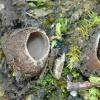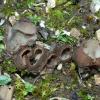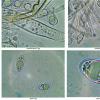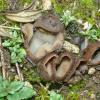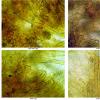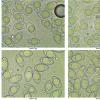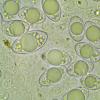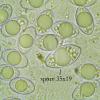
28-01-2016 09:38
 Bernard CLESSE
Bernard CLESSE
Bonjour à tous,Voici un Geopora récolté lundi d

02-02-2016 18:42
 Blasco Rafael
Blasco Rafael
Hola He visto esta Sporormiella por el tamaño de

02-02-2016 18:48
 Yannick Mourgues
Yannick Mourgues
Une idée sur cet anamorphe trouvé sur Juglans ?A

01-02-2016 20:14
Pavol PaloHi allI'm looking for full text of article publish

01-02-2016 20:19
Peter ThompsonHello Everyone, I have found a sample of what is

29-01-2016 12:23
 Lothar Krieglsteiner
Lothar Krieglsteiner
... found yesterday in Stuttgart, Germany, at nake

01-02-2016 14:14
Bonjour à tous,Enfin un peu de temps pour trier m

01-02-2016 12:59
 Blasco Rafael
Blasco Rafael
Hola, tengo esta muestra recogida sobre madera ind
Geopora sur rendzine
Bernard CLESSE,
28-01-2016 09:38
 Bonjour à tous,
Bonjour à tous,Voici un Geopora récolté lundi dernier sur micro-sol de type rendzine sur pente rocheuse calcaire xérophile.
Spores elliptiques-subfusoïdes à 1 grosse guttule centrale : 26-32x15-18
J'ai une idée…… :o))
Bernard
JJ WUILBAUT,
28-01-2016 16:40
Re : Geopora sur rendzine
peut-être foliacea
Bernard CLESSE,
28-01-2016 22:37

Re : Geopora sur rendzine
Je pense qu'il s'agit de Geopora nicaeensis avec ses spores qui dépassent régulièrement les 30 mu de long et avec cette écologie xérophile calcicole.
Bernard
Bernard
Bernard CLESSE,
29-01-2016 17:36

Re : Geopora sur rendzine
Aucun autre avis sur ce Geopora ??
Peut-on faire suivre à René Dougoud ?
Merci d'avance !
Bernard
Peut-on faire suivre à René Dougoud ?
Merci d'avance !
Bernard
Nicolas VAN VOOREN,
29-01-2016 18:31

Re : Geopora sur rendzine
Bernard, tes données sont insuffisantes pour t'aider à déterminer cette récolte. Tu n'indiques pas la taille des apothécies et, microscopiquement, la taille et les caractéristiques des poils, etc. Pour les spores, tu indiques "elliptiques-subfusoïdes", mais tes photos montrent deux profils très différents. Il conviendrait de s'assurer du profil majoritaire sur une sporée, sinon on peut conjoncturer longtemps.
Bernard CLESSE,
29-01-2016 18:35

Re : Geopora sur rendzine
D'accord Nicolas.
Avec la clé de René, comme on ne me demandait pas de tels renseignements je ne les ai pas cherchés. Les mesures de 9 spores ont été faites sur des spores hors asques, mais pas provenant d'une sporée : 27x17 - 31x16 - 28x15 - 31x15 - 26x15 - 28x17,5 - 32x15 - 28x17 - 30,5x18.
Je vais retourner en chercher sur le terrain, près de chez moi…
Bernard
Avec la clé de René, comme on ne me demandait pas de tels renseignements je ne les ai pas cherchés. Les mesures de 9 spores ont été faites sur des spores hors asques, mais pas provenant d'une sporée : 27x17 - 31x16 - 28x15 - 31x15 - 26x15 - 28x17,5 - 32x15 - 28x17 - 30,5x18.
Je vais retourner en chercher sur le terrain, près de chez moi…
Bernard
Nicolas VAN VOOREN,
29-01-2016 20:59

Re : Geopora sur rendzine
Okay, tiens moi au courant, si tu en retrouves, ça m'intéresse aussi d'examiner la récolte. J'ai en réserve d'autres collections non "déterminées"...
Bernard CLESSE,
29-01-2016 22:03

Re : Geopora sur rendzine
Sans problème Nicolas, car j'en ai laissé plein sur le terrain et je suis donc certain d'en retrouver des plus matures encore. Je ferai une sporée aussi.
Maintenant si jamais tu avais une bonne description micro avec schémas de Geopora nicaeensis, je suis toujours intéressé… :o))
Bernard
Maintenant si jamais tu avais une bonne description micro avec schémas de Geopora nicaeensis, je suis toujours intéressé… :o))
Bernard
Bernard CLESSE,
03-02-2016 12:58

Re : Geopora sur rendzine
Bonjour à tous,
Je suis repassé sur le site récupérer un nouvel échantillon du Geopora et ai réalisé une sporée.
a) spores elliptiques à tendance subfusoïde pour la plupart je pense, avec 1 grosse guttule centrale : (18)23-30(32,5-35)x14-17(18,5-19)
b) moyenne pour 20 spores = 27,47x15,9
c) Q = 1,73
d) poils brun-jaunâtre, septés, à parois épaisses (2-3 mu), obtus-arrondis au sommet, jusque 170 mu de longueur et 12 mu de largeur
e) diamètre apothécie (la plus ouverte) : 15 mm
Nicolas, si tu as une idée… et si tu veux me donner ton adresse pour t'envoyer l'échantillon, si toujours intéressé…
Bernard
Je suis repassé sur le site récupérer un nouvel échantillon du Geopora et ai réalisé une sporée.
a) spores elliptiques à tendance subfusoïde pour la plupart je pense, avec 1 grosse guttule centrale : (18)23-30(32,5-35)x14-17(18,5-19)
b) moyenne pour 20 spores = 27,47x15,9
c) Q = 1,73
d) poils brun-jaunâtre, septés, à parois épaisses (2-3 mu), obtus-arrondis au sommet, jusque 170 mu de longueur et 12 mu de largeur
e) diamètre apothécie (la plus ouverte) : 15 mm
Nicolas, si tu as une idée… et si tu veux me donner ton adresse pour t'envoyer l'échantillon, si toujours intéressé…
Bernard


